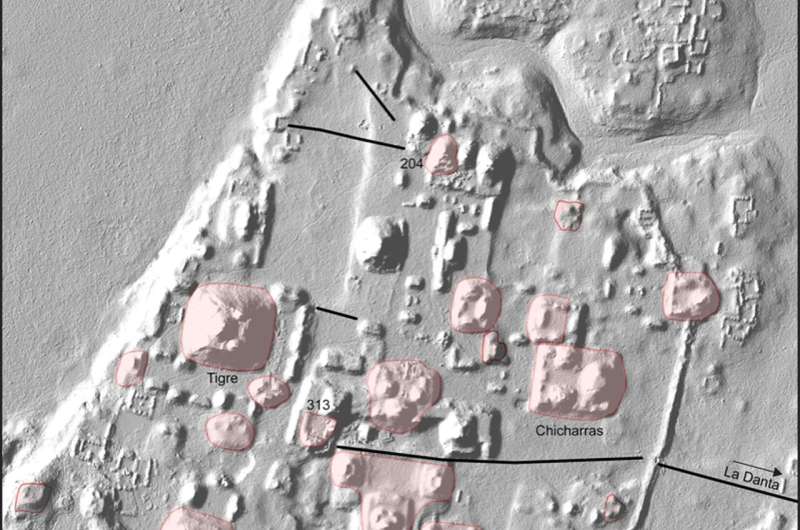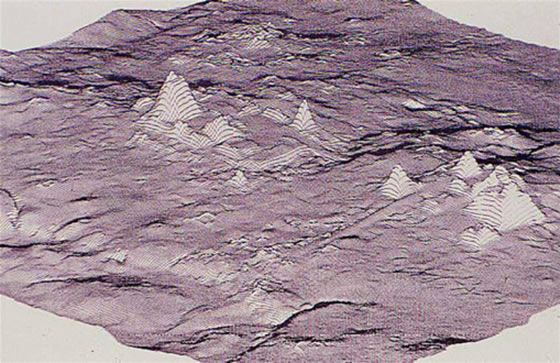Latin America
Related: About this forumArchaeologists Discover Huge Lost Civilization in Guatemala
A new survey revealed nearly 1,000 Maya settlements, with pyramids and ballcourts, that date back more than 2,000 years.
By Becky Ferreira

Archaeologists have discovered the ruins of a vast ancient Maya civilization that flourished more than 2,000 years ago in northern Guatemala, reports a new study. This long-lost urban web encompassed nearly 1,000 settlements across 650 square miles, linked by an immense causeway system, which was mapped out with airborne laser instruments, known as LiDAR.
The results of the LiDAR survey “unveiled a remarkable density of Maya sites” in Guatemala’s Mirador-Calakmul Karst Basin (MCKB) that “challenges the old notion of sparse early human occupation” in this area during the “Preclassical” period spanning 1,000 BC to 150 AD, according to a study published this month in the journal Cambridge Core.
Scientists led by Richard Hansen, an archaeologist at Idaho State University and the director of the Mirador Basin Project, offer “an introduction to one of the largest, contiguous, regional LiDAR studies published to date in the Maya Lowlands,” a region that covers parts of Mexico, Guatemala, and Belize, according to the study.
“The LiDAR survey revealed an extraordinary density and distribution of Maya sites concentrated in the MCKB, many of them linked directly or indirectly by a vast causeway network” that includes 110 miles of raised roads, the researchers continued, noting that the sprawling civilization hints at “labor investments that defy organizational capabilities of lesser polities and potentially portray the strategies of governance in the Preclassic period.”
More:
https://www.vice.com/en/article/3admdv/archaeologists-discover-huge-lost-civilization-in-guatemala
Judi Lynn
(161,491 posts)DECEMBER 22, 2022 REPORT
by Bob Yirka , Phys.org

Triadic structures in El Mirador: (a) LiDAR image showing triadic structures in the civic center of El Mirador (Tigre pyramid is the largest in this section of the city); (b) LiDAR 3D view showing the pyramidal complex of La Danta, located on the east side of the civic center at El Mirador. Credit: Ancient Mesoamerica (2022). DOI: 10.1017/S0956536122000244
A team of researchers affiliated LiDAR is a detection system similar to radar but is based on laser light rather than sound signals. In recent years, it has been used to scan parts of dense tropical rain forests for signs of ancient civilizations. Lasers used in such systems are able to penetrate vegetative canopies over rain forests, revealing what is on the ground beneath them.
In this new effort, the researchers flew over parts of Guatemala as part of a mapping effort, when they came across what they describe as a vast ancient Maya civilization. In studying their maps, they were able to see that the ancient civilization was made up of more than 1,000 settlements covering approximately 650 square miles, most of which were linked by multiple causeways. The researchers were also able to see that the people who once lived in the settlements had been densely packed—a finding that goes against theories suggesting early Mesoamerican settlements tended to be sparsely populated.with multiple institutions in the U.S., working with a colleague from France and another from Guatemala, has discovered a very large 2,000-year-old Mayan civilization in northern Guatemala. In their paper published in the journal Ancient Mesoamerica, the group describes using LiDAR to conduct a survey of the area.
The causeways (cleared, raised beds used as roads) added up to 110 miles of traversable pathways, making it relatively easy for the people in the civilization to visit other settlements. The researchers note that the road network would have allowed for collective labor efforts.
The researchers also found evidence of large platforms and pyramids in some settlements, which, they note, suggests some of them served as centralized hubs for work, recreation and politics. They note also that some of the settlements had ball courts that prior research has shown were used for playing a variety of sports native to the region. The researchers also found that the people of the civilization had built canals for moving water and reservoirs for holding it to allow for use during dry periods.
https://phys.org/news/2022-12-huge-year-old-mayan-civilization-northern.html
Judi Lynn
(161,491 posts)
El Mirador: ('The Cradle of Mayan Civilisation').
The Mayan pyramid complex of Mirador is being resuscitated from a near-death experience following a thousand years of assault by the jungles of the Guatemalan highlands. This fantastic temple complex is now realised to contain the largest pyramid on the American continent, and probably the whole world (in terms of mass).
The La Danta pyramid (right) rises approximately 70 metres (230 ft) tall from the forest floor, and considering its total volume (2,800,000 cubic meters) is now considered to be the largest pyramid in the world. (1)
The Mirador Basin in the far northern Pet�n region of Guatemala is known for its abundance of sites, many of which are among the largest and earliest in the Maya world. Of 26 known sites, only 14 have been studied; an estimated 30 more await discovery. Since 2003, Global Heritage Fund (GHF) has been working in Mirador to protect its priceless ancient cities and monuments and preserve the site for future generations. Led by project director Dr. Richard Hansen, founder and president of the Foundation for Anthropological Research and Environmental Studies (FARES), GHF has established a new 880,000-acre national park in the area, and continues to work with local communities like nearby Carmelita to ensure Mirador�s integrity and sustainability. In 2010, after completion of site conservation, El Mirador opened to the public for the first time. (2)
El Mirador: 'The Lookout'.
El Mirador was first discovered in 1926, and was photographed from the air in 1930, but the remote site deep in the jungle had little more attention paid to it until Ian Graham spent some time there making the first map of the area in 1962 A detailed investigation was begun in 1978. To the surprise of the archaeologists, it was found that a large amount of construction was not contemporary with the large Maya classic cities in the area, like Tikal and Uaxactun, but rather from centuries earlier in the Pre-Classic era.
The civic centre of the site covers some 10 square miles (26 km2) with several thousand structures, including monumental architecture from 10 to 30 meters high. Most of the structures were originally faced with cut stone which was then decorated with large stucco masks depicting the deities of Maya mythology. According to Carlos Morales-Aguilar, a Guatemalan archaeologist, the city appears to have been planned from its foundation, as extraordinary alignments have been found between the architectural groups and main temples, which were possibly related to solar alignments. The study reflects an importance of urban planning and sacred spaces since the first settlers.

The 'El Tigre' and 'La Danta' pyramid complexes were built to face each other.
An additional feature of El Mirador is the quantity and size of causeways (see above), internally linking important architectural compounds, and externally linking the numerous major ancient cities within the Mirador Basin during the latter part of the Middle and Late Preclassic periods. The causeways were known anciently as sacbeob (the plural form of sacbe, meaning "white road" in Mayan, from sac "white" and be "road"
This large concentration of Preclassic Maya cities in Mesoamerica is threatened by massive deforestation, looting, and destruction caused by equipment used in logging road construction, which itself facilitates intrusive settlements.
. . .

Artists impression of Mirador in its Heyday.
More:
http://www.ancient-wisdom.com/guatemalamirador.htm
Judi Lynn
(161,491 posts)Adding a video from National Geographic, created 4 years ago, which is beautifully done, and interesting:
brer cat
(25,260 posts)Judi Lynn
(161,491 posts)Really hoping they will be publishing updates from their work, as they progress.
Developing lasers capable of penetrating dense jungles to inform modern human beings of the high state of civilization there was among the people they have always imagined as primitive "savages" is a perpetual gift.
It's always waiting ahead of us, to astound, and overwhelm us, and make us eager for more. What a time in history it must be for archaeologists! ![]()
Judi Lynn
(161,491 posts)BY MOIRA RITTER
DECEMBER 21, 2022 1:20 PM

Researchers discovered an ancient Mayan kingdom from 2,000 years ago in northern Guatemala, a new study shows. Cambridge University Press.
An ancient Mayan kingdom from some 2,000 years ago was discovered buried in northern Guatemala, researchers say.
Archaeologists uncovered nearly 1,000 ancient Mayan settlements in the Mirador-Calakmul Karst Basin and surrounding ridge. In these settlements they identified 417 cities, towns and villages that existed in the period between 1,000 B.C. and 100 A.D., according to a study published online Dec. 5 by the Cambridge University Press.
Using LiDAR technology, — a remote sensing method that generates three-dimensional images and information about the Earth’s surface, according to the National Oceanic and Atmospheric Administration — researchers determined that the settlements comprised a more sophisticated and interconnected kingdom.
Archaeologists said their findings show a highly-functional state-level kingdom “connected by causeways, forming a web of implied social, political, and economic interactions” and “that required vast amounts of labor and resources, amassed by a presumably centralized organization and administration.”
Here are some of their findings.
More:
https://www.charlotteobserver.com/news/nation-world/world/article270281297.html
(Subscription only, you might want to use this one: )
https://archive.ph/WJupy#selection-1123.43-1171.32
Bayard
(23,001 posts)Thanks for posting.